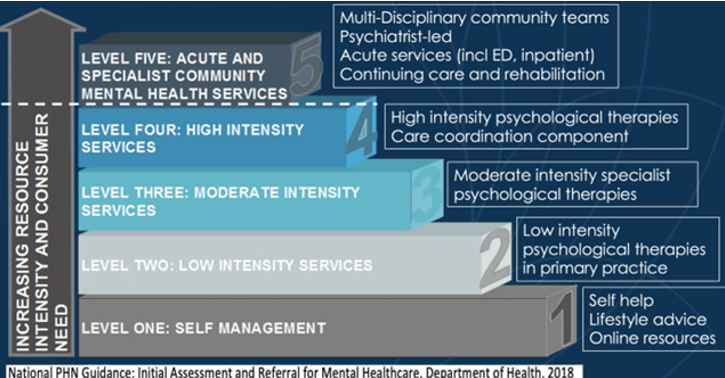Service Delivery
Service Delivery Implementation Guidance
Adopt a stratified care approach
 The right care, matched to an individual’s needs and delivered early in the course of illness, is critical to reducing service gaps. Stratified care is an evidence-based, integrated care system comprising a hierarchy of service levels, from the least to the most intensive. When a young person enters the system, and as circumstances change, your organisation should seek to match the intensity of care needs by stepping up and stepping down through different service levels.
The right care, matched to an individual’s needs and delivered early in the course of illness, is critical to reducing service gaps. Stratified care is an evidence-based, integrated care system comprising a hierarchy of service levels, from the least to the most intensive. When a young person enters the system, and as circumstances change, your organisation should seek to match the intensity of care needs by stepping up and stepping down through different service levels.
In an integrated environment of multiple providers, you can discuss with your network which services will cover each level of the stratified model and clarify the type of treatments each service can provide. Once an agreement has been reached, it may be useful to create a diagram like the one above so all network members are aware of their position in the system.
Implement centralised intake, assessment and referral systems

Young people’s pathways to care can be complex, chaotic and inefficient. Centralised intake, assessment and referral systems can facilitate single points of entry and enable more efficient access to primary, secondary and tertiary services. This can be achieved with:
- Standardised tools such as the Initial Assessment and Referral Decision Support Tool for shared language and rapid cross-referral
- Warm referrals between services
- Joint intake assessments and consent to share patient information to avoid duplicating screenings or assessments
- Commitment to providing feedback on referrals from partners.
- Nominated key contacts in each service to support referrals and build relationships between services
- A ‘community of practice’ with joint learning across services (e.g. new staff orientation, training, planning, clinical discussion forums and intake meetings)
Completed all the resources for Service Delivery? Explore the others
Brings together the strengths of four founding organisations




